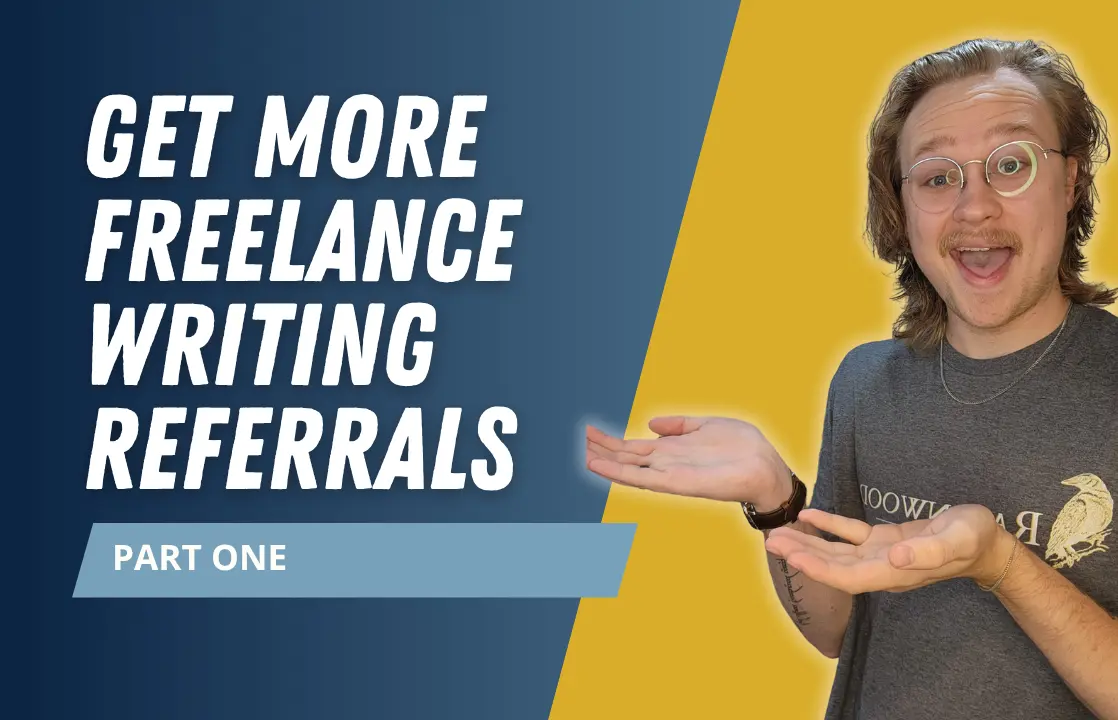Imagine a business where leads show up in your inbox without cold outreach, wasting hours on job boards, or constantly self promoting. It’s the dream for freelancers.
Luckily, with a bit of intentional planning, you can make it a reality for your writing business.
Most freelancers have heard they should “just ask for referrals.” Although it’s true, the advice usually stops there.
But that’s only one piece of the puzzle. High-quality client referrals don’t come from wishful thinking.
In this three-part series, I’ll show you how to create a system to attract referrals naturally that you don’t have to feel awkward about.
1.) Rethink What Triggers Referrals
Clients don’t refer you to their peers just because you did a great job. They’re busy running their own business. Yes, if you have a great relationship, you can just ask.
But clients will get excited about referring you when:
- They’re surprised by the value you deliver
- You give them a reason to talk about you
- They know exactly who would benefit from your work
Pro Tip: At the end of every project, find a “surprise and delight” opportunity. Maybe it’s an unexpected deliverable (e.g. a content calendar for the next quarter or an infographic to accompany your article).
2.) Build a Signature Offboarding Process
You hear a lot about onboarding new clients. It’s crucial to job success. However, most referrals come after a project is done when your name pops into your client’s head.
An offboarding process wraps up your work, highlights the client’s results, and makes it easy to pass your name along.
Here are a few can’t-miss includes for your offboarding toolkit:
- A recap email of what you did. Be sure to include before/after snapshots or ROI results if you have them.
- A “looking forward” note that outlines next steps if they want to work with you again (this plants the seed of how others can hire you, too).
- A short (1-2 minute) Loom video thanking the client, highlighting a big win or insight, and inviting them to stay connected. This is much more memorable than an email.
- A referral bonus for successful referrals. Consider offering discounts on future services or a free strategy session.
- Invite them to leave a testimonial. You can even offer to write the draft to make it easier if they’re busy.
- If they show interest, have a one-pager ready. It should be a simple PDF that explains what you do, who you help (your niche / client avatar), what problems you solve, and how to get in touch.
I like using a pre-saved email template to systemize this. It makes it quick and easy to offboard a client after a project without it becoming a time sink.
3.) Keep the Feedback Funnel Flowing
After you finish a project, the work might not stop there. You’ll hopefully keep working with the client on other projects. Either way, it’s important to keep pushing for referrals long after the original work is done.
Getting referrals is all about timing. If the client doesn’t know someone who could benefit from your services right then, that’s okay. You just need to stay top-of-mind when the opportunity arises.
I use a multi-layered follow-up system that’s earned me referrals worth thousands of dollars. Here’s how it works:
- Week 2-3: Send a “How’s it Landing?” check-in email. Ask if they’ve used the content and what results they’re seeing. This reinforces your impact and gathers social proof all at once.
- Month 1-2: Invite them to contribute to a “Client Spotlight” series on your blog or in a case study. This flatters the client, gives them visibility, and lets you showcase your work with their name on it.
- Quarterly: Share a relevant content strategy tip via email. The goal is to deliver free value and boost your “wow factor.” With it, add a P.S. like “If you know someone who could benefit from this, feel free to introduce us.”
The goal here isn’t a hard ask. You just need to stay present and continue delivering value. Trust me, clients notice this and it puts you above and beyond other freelancers who disappear after submitting their work.
The Takeaway
Early in my freelance career, I assumed doing great work was enough. It brought clients back for more, but it didn’t fill my pipeline of new leads. When I started building referral moments into my process, my clients now brought others with them.
Referrals happen when you give people a reason to talk.
In part two, we’ll explore how to turn your network (non-clients) into a referral engine that lets you stop chasing leads.


